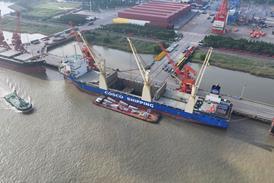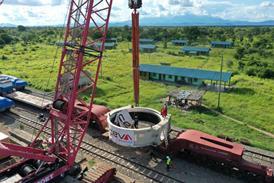Mammoet has developed a fixed-jib configuration for its SK6,000 ring crane that allows offshore wind developers to reach deeper waters and cut the cost of floating wind assembly.

The transport engineering and heavy lift specialist said that fixed-bottom turbines and their foundations are growing fast, so projects can be built further from the coast where winds are stronger and greater yields can be achieved. As a result, jackets and monopiles are reaching both the height and weight capacity of the world’s largest cranes.
The SK6,000, which was announced this year and will have a 6,000 tonne lifting capacity, will be available with a fixed jib configuration that means lifts of 3,000 tonnes at a height of 220 m are now possible.
Mammoet said that as the industry moves towards 20 MW turbines, there is an increased need for modular approaches to speed up the construction process, and to allow developers to install more floating turbines in reduced weather windows. With this new configuration, the crane can load out floating foundations using its main boom, then immediately use its fixed jib to assemble the turbine tower. No reconfiguration will be necessary between scopes, further improving build efficiency.
“We don’t look at the SK as ‘just’ a crane, but we look at it as a system as well. If you look at the SK of today compared to when it was first launched, it has evolved considerably,” said Mammoet technical expert Jeremy Haylock. “This isn’t a surprise because it was always the basis of our original design philosophy, and we wanted to develop a product that would be scalable and agile. Because the world is developing so quickly, and the changes around us are so vast, our aim was to deliver a product that would allow us to grow in real time with our customers.”
He added: “As with every part of the SK, when we developed the fixed jib we wanted to include room for growth. With the SK6,000 jib we are employing that additional capacity through small adjustments to the original design.
“The fixed jib is fully forward and backward compatible through the SK series, meaning our customers can realise its potential, regardless of the application.”
















